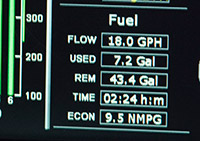Dogfight: Running lean of peak
"Go ROP, and have peace of mind" vs. "Asked and answered"
Related Articles
Editor at Large Tom Horne and Senior Editor Dave Hirschman have a lot of things in common: lots of ratings, lots of experience in lots of airplane models—and lots of opinions (as well as similar haircuts). We last turned them loose on the topic of pattern entry (see “ Dogfight: Running the Tank Dry,” March 2011 AOPA Pilot) and the response to two different schools of thought on this topic garnered some of our most interesting musings—and the largest amount of letters—from a number of readers. So we launch them into another “Dogfight”—we hope you’ll enjoy these two takes on a topic, and keep those cards and letters coming. —Ed.
Go ROP, and have peace of mind
Rich of peak EGT: Tried and true
 By Thomas A. Horne
By Thomas A. Horne
To me, there’s something reassuring about running an engine 50 degrees Fahrenheit—or 100 degrees, for a best-power mixture—rich of peak (ROP) exhaust gas temperature (EGT) when cruising at 75-percent power. And I’m sure the vast majority of pilots would agree with me.
That’s because airplanes in the general aviation fleet are mostly carburetor-equipped, and lack the fancy new engine analyzers that make safe lean-of-peak EGT operations possible. Fly a carbureted airplane? Don’t have an EGT gauge or an engine analyzer? Want to fly at 50 degrees rich of peak? Then simply lean the mixture until the engine begins to run rough, then enrichen the mixture slightly—until the roughness goes away. It’s as simple as that.
Typically, the scale’s graduation marks are in 25-degree intervals, so dialing in a 50-degree rich of peak setting is as simple as enrichening two intervals’ worth.
Although these are simple procedures, remember that until the 1970s peak EGT and running at certain rich-of-peak EGT settings were alien concepts. Some flight instructors never taught their students how to lean the fuel-air mixture! Sure, airline and military crews flying reciprocating-engine airplanes knew all about running rich—and lean—of peak EGT. But they had flight engineers whose jobs included constantly monitoring and adjusting mixtures for given power settings. Adjusting mixtures was a job separate from flying the airplane!
Sure, you can run lean of peak, but you’d better know what you are doing.
But today, running rich of peak EGT is no big deal. And, after 40 years of flying rich of peak, the verdict is in: Rich-of-peak operations mean safe margins from detonation, running hot enough to keep lead deposits to a minimum, and yet cool enough to prevent damage to exhaust valves and other top-end components.
Now the lean-of-peak (LOP)-EGT bandwagon seems to be in vogue. This tactic uses mixture settings that rely on the air in the fuel-air mixture to do the cylinder cooling. It requires precisely calibrated fuel injectors (General Aviation Manufacturers Inc.’s GAMIjectors being the most popular) that create evenly distributed cylinder head temperatures (CHT), the afore-mentioned engine analyzing gear, and no small amount of finesse in the leaning process.
Here’s where problems can crop up. Sure, you can run lean of peak, but
you’d better know what you’re doing. (Maybe you should hire a flight engineer?) Stories abound of pilots misinterpreting CHT, EGT, fuel flow, or other indications. Some analyzers are more intuitive than others, so the leaning sequence can be confusing.
 Rich-of-peak operations typically produce higher power outputs and faster cruise speeds. The downside? Higher fuel flows. Here, a Cirrus is running at 100 degrees rich of peak (a best power mixture), but at a cost of 18 gph.
Rich-of-peak operations typically produce higher power outputs and faster cruise speeds. The downside? Higher fuel flows. Here, a Cirrus is running at 100 degrees rich of peak (a best power mixture), but at a cost of 18 gph.
I’ve seen some pilots referring to a “cheat sheet” every time they go LOP. Instant recall eludes them, and they can’t quickly recall the steps to get
to the LOP promised land. For many, the procedure is simply counter-intuitive and slightly unsettling. Does air really do a better job at cooling than fuel?
Is there enough fuel in my fuel-air
mixture to prevent detonation? Thoughts like these cross your mind when you go to LOP-land. And understandably so.
That’s because there’s a danger in misinterpreting temperature indications—and running at a mixture setting that will damage your cylinders.
So what’ll it be for you? The comfort of ROP operations, or the complexity, potential confusion, and risk of damage that can come with running LOP?
Yes, lean-of-peak operation promises lower fuel burns and less fouling of spark plugs and valve assemblies. But is it worth it?
I once asked a mechanic, and owner of an engine shop, what he thought of cruising at lean-of-peak mixture settings. “I think it’s great!” he effused. “My top-end business is shooting out the roof!”
Makes you wonder.
E-mail the author at [email protected].
Asked and answered
What are we still arguing about?
 By Dave Hirschman
By Dave Hirschman
As pilots, we like to think of ourselves as a data-driven, analytical, factual bunch.
We call our certificates “licenses to learn,” and embrace the concept of a lifetime pursuit of greater knowledge and skill. We’re all spiritual inhabitants of Missouri (the Show Me state).
But when the subject turns to lean-of-peak engine operations, inexplicably, we jettison all that and allow the debate to become emotionally charged, superstitious, and accusatory. Certainly, we’re all entitled to our opinions—but not our own facts.
And in fact, during the past 10 years, more than 20,000 general aviation engines have logged millions of flight hours (and avoided burning tens of millions of gallons of avgas) by running lean of peak—and their safety records and maintenance histories are every bit as good as similar engines flown rich of peak during the same time period.
Aircraft builders such as Cirrus have revamped pilot’s operating handbooks to embrace lean-of-peak operations; Teledyne Continental Motors has done the same for its turbocharged IO-550T; and engine rebuilders once disdainful of lean-of-peak practices have come to recommend them (as long as pilots understand the procedures and engines are equipped with precisely matched fuel/air metering systems and graphic engine analyzers showing CHT and EGT for every cylinder).
New technology being developed for the GA fleet such as FADEC and electronic ignitions promise to spread the efficiency and reliability of lean-of-peak flying even more broadly in the future.
So what are we still arguing about? What data points are lacking to reach an informed conclusion? Here’s one example that shows why definitive proof is so elusive.
I recently watched Bonanza expert Adrian Eichhorn perform a cylinder inspection on a healthy-looking Continental IO-550 using a high-tech medical probe with an attached video camera (“Frugal Flier: Will Medicare Cover This?” in next month’s issue). The engine had logged 1,300 hours since overhaul and had been operated both lean and rich of peak. Five of the engine’s six cylinders looked flawless internally, but one showed discoloration and visible wear on one of the exhaust valves.
Was that valve damage caused by excessive heat from leaning too aggressively at high power? Or did it happen during full-power takeoffs and climbs when the mixture knob was in the full rich position but fuel flow to that cylinder was somehow restricted?
Eichhorn was too savvy to take the bait. He said diplomatically that there was no way to tell from the information given.
Engines operated properly LOP are cleaner internally with less damaging crud in the case or residue in the cylinders.
Even though many pilots would consider 1,300 hours from a set of IO-550 cylinders a moral victory, let’s assume for the sake of argument that lean-of-peak operation was to blame for this cylinder’s woes.
An IO-550-powered Bonanza flying rich of peak typically consumes about 18 gallons of fuel an hour. Lean of peak, that number is reduced to about 13 gph. If this engine operated 500 hours lean of peak (and that number is probably low), the five gph fuel savings at $4.50 a gallon was $11,250—more than enough to pay for the required valve work.
 Now that the same Cirrus is running at lean-of-peak EGT, cylinder head temperatures and fuel flows are lower than when flying rich-of-peak. The downside here? Slower cruise speeds.
Now that the same Cirrus is running at lean-of-peak EGT, cylinder head temperatures and fuel flows are lower than when flying rich-of-peak. The downside here? Slower cruise speeds.
On a larger scale, the numbers are even more impressive. More than 20,000 GA engines are equipped to run LOP, and assuming just half of them do so for 125 hours a year at a fuel savings of 2.5 gph per engine, they save 3.1 million gallons of fuel (and $14 million) annually.
But the real reason to operate lean of peak isn’t economy, or range extension, or saving the planet (although those things are nice!). The real reason to do it is to make your airplane fly safer and longer. Ask the people who make their living overhauling and maintaining piston aircraft engines (Bill Cunningham and Monty Barrett in Oklahoma are good places to start) and they will tell you that engines operated properly LOP are cleaner internally with less damaging crud in the case or residue in the cylinders.
The whole story in keeping cylinders healthy is keeping them cool (below 380 degrees F), Cunningham says. Whether that’s done by enriching the mixture and pouring unburned fuel through them, or a very lean setting that restricts fuel and creates less heat from combustion, is up to you.
Questions about the benefits of lean-of-peak operations have been asked and answered.
E-mail the author at [email protected].


